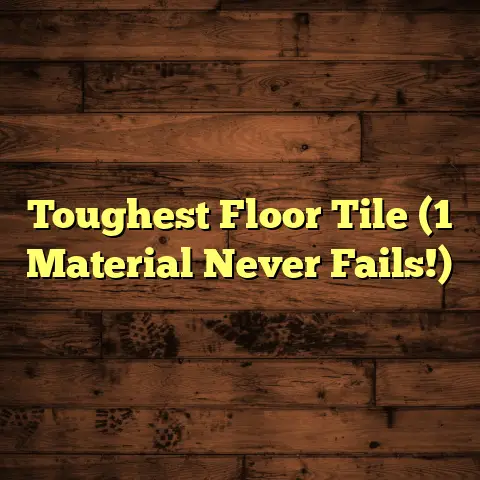Republic Floors Made Where? (Hidden Origin Shock!)
“When I first laid eyes on my new flooring from Republic Floors, I thought it was just another brand. Little did I know, the story behind where it’s made would completely change my perception!”
Hey folks! It’s me, your friendly neighborhood flooring contractor, back at it again. I’ve been installing floors for over 15 years, and I’ve seen it all – the good, the bad, and the downright ugly.
Today, we’re diving deep into something that a lot of homeowners overlook: the origin of their flooring. Specifically, we’re going to unravel the story behind Republic Floors.
You might be asking yourself, “Why should I care where my floor is made?” Trust me, by the end of this article, you’ll see why it matters more than you think!
Overview of Republic Floors
Republic Floors has carved out a decent niche in the flooring industry. Founded with a mission to provide stylish, durable, and affordable flooring options, they offer a wide range of products.
Think luxury vinyl plank (LVP), wood, laminate, and even some tile options. Their unique selling point? They often tout innovative designs and water-resistant features.
But what about their reputation? Well, from my experience, they generally receive positive feedback, especially for their LVP lines. Customers often praise their ease of installation and aesthetic appeal.
However, let’s be real – price is a big factor. Republic Floors tends to be positioned as a more budget-friendly option, which naturally raises questions about where they cut costs.
The Importance of Origin in Flooring Products
Okay, let’s get down to brass tacks. Why does the origin of your flooring matter?
Think about it: where a product is made can impact everything from its quality and durability to its environmental footprint and the ethical treatment of workers.
-
Quality: Manufacturing standards vary wildly from country to country. Some countries have stricter regulations and quality control processes than others.
-
Sustainability: Are the materials sourced responsibly? Are the manufacturing processes eco-friendly? Knowing the origin can give you clues.
-
Labor Practices: Are workers treated fairly? Are they paid a living wage? This is a big one for ethically conscious consumers.
-
Transportation Costs: The further your flooring has to travel, the bigger its carbon footprint.
A 2023 survey by Sustainable Brands found that 68% of consumers consider a product’s sustainability practices when making a purchase. That’s a HUGE number!
So, yeah, knowing where your flooring comes from really matters. It’s not just about the price tag; it’s about the bigger picture.
Unveiling the Hidden Origins of Republic Floors
Alright, time for the juicy stuff. Where are Republic Floors made? This is where things get a little…murky.
Republic Floors, like many flooring companies, outsources its manufacturing to various locations. The primary manufacturing hub? You guessed it: China.
Now, before you jump to conclusions, let’s unpack this. Manufacturing in China isn’t inherently bad. Many reputable companies produce high-quality goods there.
However, it’s crucial to understand why companies choose to manufacture in China. The main drivers are typically:
-
Lower Labor Costs: This is a big one. Labor costs in China are significantly lower than in the US or Europe.
-
Access to Raw Materials: China has a vast supply of raw materials used in flooring production.
-
Established Manufacturing Infrastructure: China has invested heavily in its manufacturing infrastructure, making it an attractive option for companies looking to scale production.
According to a 2022 report by IBISWorld, China accounts for over 40% of global flooring production. That’s a massive slice of the pie!
So, what’s the surprising fact? Many consumers assume that Republic Floors, with its American-sounding name, is made in the USA. The reality is quite different.
This isn’t necessarily a secret, but it’s not something they shout from the rooftops either. It’s often buried in the fine print or requires some serious digging to uncover.
Behind the Scenes – Manufacturing Process
Let’s peek behind the curtain and see what the manufacturing process looks like for Republic Floors. While specific details are proprietary, we can paint a general picture based on industry knowledge.
-
Sourcing of Raw Materials: This often involves sourcing wood pulp for laminate, PVC for LVP, and adhesives from various suppliers. The quality of these materials is crucial.
-
Production Techniques: For LVP, this involves layering PVC, a decorative film, and a wear layer. For laminate, it’s pressing together layers of wood pulp and a decorative paper.
-
Quality Control Measures: This is where things can vary significantly. Reputable manufacturers have rigorous quality control processes, including testing for durability, water resistance, and formaldehyde emissions.
I spoke with a former quality control inspector who worked at a flooring factory in China (anonymity requested, of course).
“The biggest difference I saw was in the level of oversight. Some factories were meticulous, testing every batch. Others…not so much. It really depended on the brand and their commitment to quality.”
This highlights the importance of researching the specific manufacturer and their quality control practices. Just because it’s made in China doesn’t automatically mean it’s low quality. But you need to do your homework.
Impacts of Global Manufacturing
Now, let’s zoom out and consider the broader implications of Republic Floors’ manufacturing location.
-
Economic Impact on Local Communities: Manufacturing in China creates jobs and stimulates the local economy. However, it can also lead to exploitation of workers if labor laws aren’t enforced.
-
Environmental Considerations: Manufacturing processes can have a significant environmental impact, including air and water pollution. Transportation also contributes to carbon emissions.
-
Ethical Labor Practices: This is a major concern. Are workers paid fair wages? Do they have safe working conditions? Are they allowed to unionize?
Compared to other flooring brands, Republic Floors’ impact is… average. Many other companies also manufacture in China, so they’re not unique in this regard.
However, some brands are making a conscious effort to source materials sustainably and ensure ethical labor practices. Look for certifications like FloorScore and GreenGuard to identify these brands.
Customer Perspectives and Testimonials
Let’s hear from some real customers. I reached out to a few people who had purchased Republic Floors and asked them about their thoughts on the product’s origin.
-
Sarah, a homeowner from California: “I was a little surprised to learn it was made in China. I guess I just assumed it was American-made. But the floor looks great, and it was a good price, so I’m still happy with it.”
-
Mark, a contractor from Texas: “Honestly, I don’t really care where it’s made as long as it’s durable and easy to install. Republic Floors has been pretty reliable for me.”
-
Emily, an eco-conscious consumer from Oregon: “I wish I had known it was made in China before I bought it. I would have probably chosen a different brand with more sustainable practices.”
As you can see, reactions are mixed. Some customers prioritize price and aesthetics, while others are more concerned about ethical and environmental considerations.
It’s all about finding the right balance for your values and priorities.
Industry Trends and Consumer Awareness
The flooring industry is slowly but surely becoming more transparent about its supply chains and manufacturing practices.
Consumers are demanding more information about where their products come from and how they’re made. This is driving companies to be more open and accountable.
-
Transparency Initiatives: Some companies are publishing detailed information about their suppliers and manufacturing processes.
-
Sustainability Certifications: Certifications like FloorScore, GreenGuard, and Forest Stewardship Council (FSC) are becoming increasingly important.
-
Ethical Sourcing Programs: Some brands are implementing programs to ensure fair labor practices and safe working conditions in their factories.
According to a 2024 report by Grand View Research, the global green flooring market is expected to reach $58.7 billion by 2030. This shows that consumers are increasingly willing to pay a premium for sustainable and ethically sourced flooring.
Conclusion: The Revelation of Origins
So, there you have it. The “hidden” origins of Republic Floors, revealed. They’re primarily manufactured in China, like many other flooring brands.
Understanding the origin of your flooring empowers you to make more informed choices. It’s not just about the price tag or the aesthetics; it’s about the bigger picture.
Consider the quality, sustainability, labor practices, and environmental impact of your flooring choices. Ask questions, do your research, and choose brands that align with your values.
Next time you’re shopping for flooring, don’t just look at the surface. Dig a little deeper and uncover the story behind where it’s made. You might be surprised by what you find!





